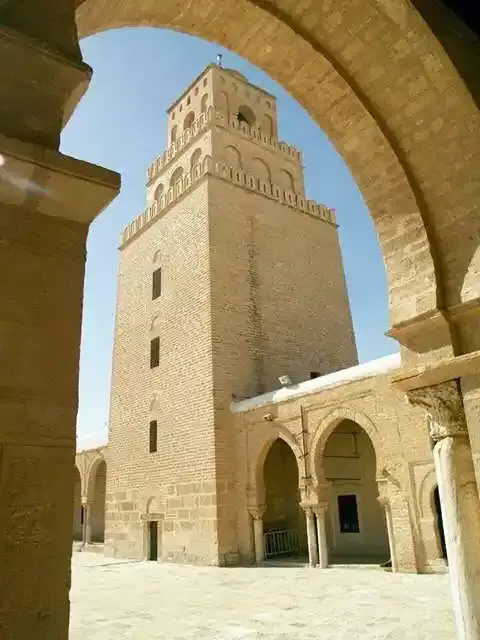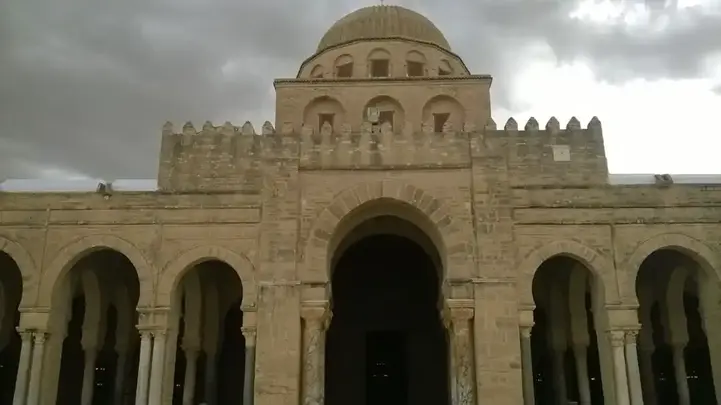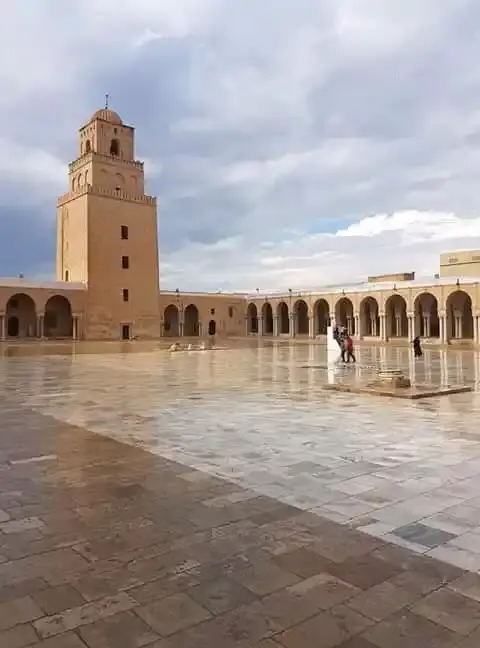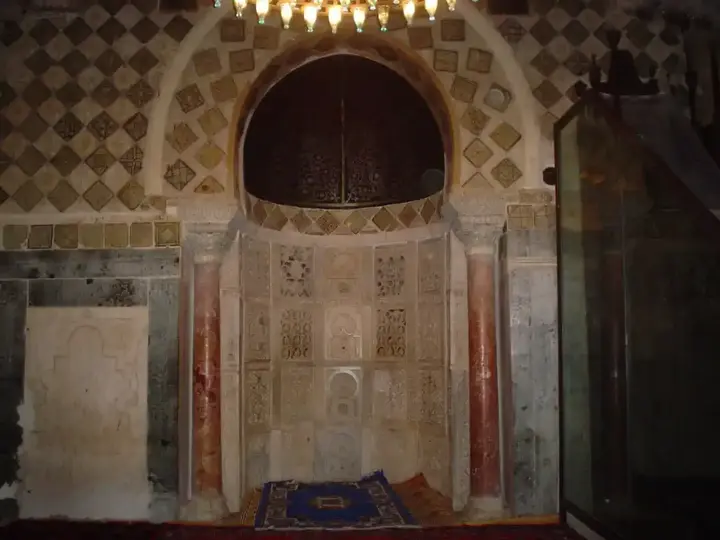Uqba Ibn Nafi Mosque in Kairouan: an architectural masterpiece and a prominent historical and tourist landmark

Uqba Ibn Nafi Mosque is the first and oldest mosque in Tunisia and North Africa, and is considered one of the most important Islamic landmarks in the world. It is located in the city of Kairouan, which was founded in 50 AH / 670 CE by the companion Uqba ibn Nafi', the commander of the Islamic army that conquered Ifriqiya.
Show key points
- The Uqba Ibn Nafi Mosque, built in 670 CE by the companion Uqba ibn Nafi’, is the oldest mosque in North Africa and a significant Islamic architectural and religious monument.
- Over the centuries, the mosque underwent numerous renovations under different dynasties like the Umayyads, Abbasids, Fatimids, and Hafsids, each adding unique architectural and decorative elements.
- The mosque's interior is divided into arcades, a courtyard, and a prayer hall, with the latter being its most magnificent section, accommodating around 9,000 worshippers.
- ADVERTISEMENT
- Featuring remarkable decorations such as intricate woodwork, floral and geometric motifs, and stunning marble mihrab carvings, the mosque showcases the richness of Islamic art.
- Its iconic minaret, distinguished by a three-tiered square structure and a lobed dome, inspired the design of many later Maghrebi minarets.
- Historically, the mosque served not only for worship but also as a center for education, scholarship, cultural exchange, and launching Islamic conquests in the Maghreb and Andalusia.
- Today, the mosque remains a symbol of Kairouan’s heritage, significantly contributing to the city's cultural tourism and economic growth.
The mosque contains several architectural, artistic and historical elements representing the various eras and civilizations that Kairouan went through. In this article, we will learn about the history of the construction of the mosque, its magnificent decorations and its description from the inside, and we will evaluate its importance, beauty and splendor as a unique Islamic landmark.
Recommend
The history of the construction of the Uqba bin Nafi Mosque

The mosque dates back to the reign of the companion Uqba ibn Nafi', who built it in 50 AH / 670 CE as a mosque for prayer and a center for da'wah and education. The mosque was simple and modest at the beginning, and consisted of an open courtyard and a prayer house covered with straw and wood. During the Umayyad Caliphate, the mosque was expanded and a minaret, domes, fences, and doors were added.
During the Abbasid Caliphate, the mosque was renovated and decorated with columns, muqarnas, inscriptions and decorations. Under the majority state, the mosque was reinforced and fortified with towers and cannons. During the Fatimid dynasty, the mihrab and minbar were changed and the console and silo were added.
During the Senhaji dynasty, the mosque was restored and improved with wooden ceilings, umbrellas, chandeliers, and lamps. During the Hafsid dynasty, the mosque was provided with reservoirs, water, a library, a school, tombs, and shrines. In this way, the mosque has undergone several changes and developments over the centuries and has become a witness to the history and civilization of Islam in North Africa.
Decorations of Uqba bin Nafi Mosque

The mosque is characterized by its wonderful and diverse decorations, which reflect Islamic art, beauty and creativity. From the outside, the mosque looks fortified and impregnable, resembling a castle or fortress. It is surrounded by high and sturdy walls, decorated with towers, domes, doors and symmetrical windows.
Among the finest decorations of the mosque are the decorations of the mihrab and dome. The mihrab features exquisitely carved motifs on marble, which add a unique artistic touch. These motifs have been carefully designed, forming paintings with fine detail.
The dome is covered with floral motifs in the form of a medium leg or wavy branches, from which bunches of grapes hang, adding to the dome a special attraction and artistic beauty that distinguishes it from others. As for the minbar, it appears with exceptional artistic skill, as it is carved on wood, and is full of geometric and floral motifs that embody the authenticity of Islamic art.
Description of Uqba Ibn Nafi Mosque from the inside

Inside, the mosque is divided into three main sections: the arcade, the courtyard and the prayer house. The arcades are covered corridors that surround the courtyard on three sides, and contain columns, muqarnas, mashrabiyas and inscriptions.
The nave is an open space used for prayer, teaching, and meetings, decorated with trees, palms, flowers, and fountains. The prayer house is the largest and most important section in the mosque, and can accommodate about 9,000 worshipers, and contains several important artistic and historical elements, such as the mihrab, the minbar, the comforting cabin, and the minaret.

Prayer House:
The prayer house is the most beautiful and magnificent part of the mosque, and deserves to be described in detail. It consists of 17 parallel ships, intersecting with 15 vertical ships, forming a grid of 415 rectangular sections, each covered with a square wooden roof. The wooden ceilings are considered one of the finest works of art in the mosque, and are decorated with geometric, floral and calligraphic inscriptions and motifs, in a variety of colors and shapes.
Parachutes:
Umbrellas are canopy hanging awnings, placed over wooden ceilings, to protect them from dust, heat and moisture. Chandeliers, lamps, mirrors and carpets are other elements that add to the beauty and splendor of the prayer house, and reflect luxury, sophistication, and elegance.

Mihrab:
The mihrab is an opening in the wall, indicating the direction of the qibla, and decorated with inscriptions and decorations.
Pulpit:
The pulpit is a raised wooden platform, used to deliver a sermon.
Console cabin:
The Mu'azi cabin is a closed wooden cabin, used for the prayer of the Fatimid Caliph al-Mu'izz li-Din Allah.
Minaret:
The minaret of the Uqba Ibn Nafi Mosque is among the oldest and most beautiful minarets erected by Muslims in Africa. Its beauty and history extend to inspire the many minarets erected in the Maghreb after it.
All the minarets that followed in that area were characterized by a similar design, differing from them only in minor details. Some minarets, such as the minaret of the Sfax Mosque, the minarets of the mosques of Tlemcen, Agadir, Rabat and the Mosque of Al-Qarawiyyin, were very similar to this minaret.
The minaret of the Uqba Ibn Nafi Mosque consists of three layers, all with a square-shaped design. The second layer is slightly smaller than the first, and the third layer is slightly smaller than the second. This artistic structure is completed by a lobed dome crowned above the three layers. The height of the minaret reaches 31.5 meters, all of which highlights the splendor and uniqueness of this Islamic architectural achievement.
The importance of Uqba Ibn Nafi Mosque in Islamic history

The Uqba Ibn Nafi Mosque is not only an architectural building, historical or tourist landmark, but also a witness to the role of Islam in spreading science, culture and civilization in North Africa, the Maghreb and Andalusia. The mosque was a center for advocacy, education, research and publication in various sciences, arts and knowledge.
The mosque received many companions, followers, scholars, thinkers, writers, jurists, modernists, and mystics.
The Uqba Ibn Nafi Mosque witnessed a remarkable cultural renaissance, as it was the focus of education, jurisprudence, hadith, and mysticism. Through its corridors came many scholars, imams and mujaddids, such as Imam Sahnoun, Ibn Rashiq al-Qayrawani, Ibn Sharaf, Ibn al-Jazzar, and others. The influence of these scholars and thinkers is not limited to the eras that followed the establishment of the mosque, but continued to shape the course of Islamic history and thought.
The Uqba Ibn Nafi Mosque served as a starting point for the Islamic conquests in the Maghreb, Andalusia and Sicily. From this place came the Muslim armies, spread Islam in these countries and carry the message of Islam, justice and civilization.
The mosque was a vital center for mujahideen and preachers, who made tremendous efforts in establishing and teaching Islam. The mosque witnessed many battles and victories, which immortalized the history of the Islamic conquests and established their legacy in historical memory.
The importance of the Uqba Ibn Nafi Mosque in the city of Kairouan

The Uqba Ibn Nafi Mosque is not only a symbol of Islamic history and civilization in North Africa, but also an important factor in the development of the city of Kairouan and the movement of economic and tourism in it. The mosque attracts visitors and interested people from all over the world, who come to see its greatness, beauty and splendor, and to enjoy the arts, decorations and landmarks it contains. The mosque also contributes to the revival of heritage and culture.
The mosque also promotes economic and social activity in the city of Kairouan, supporting various sectors such as transport, housing, trade, industry, and services. The mosque thus represents a source of income, luxury, progress and prosperity for the city's residents and visitors.
This was a tour of the city of Kairouan, we got to know the Uqba Ibn Nafi Mosque, an architectural masterpiece and a prominent historical and tourist landmark. We learned about the history of the mosque's construction, its magnificent decorations and its description from the inside, and valued its importance, beauty and splendor as a unique Islamic landmark. The mosque is considered one of the most important Islamic landmarks in the world, and it is worth visiting and discovering. We hope this article was useful and interesting to you.








